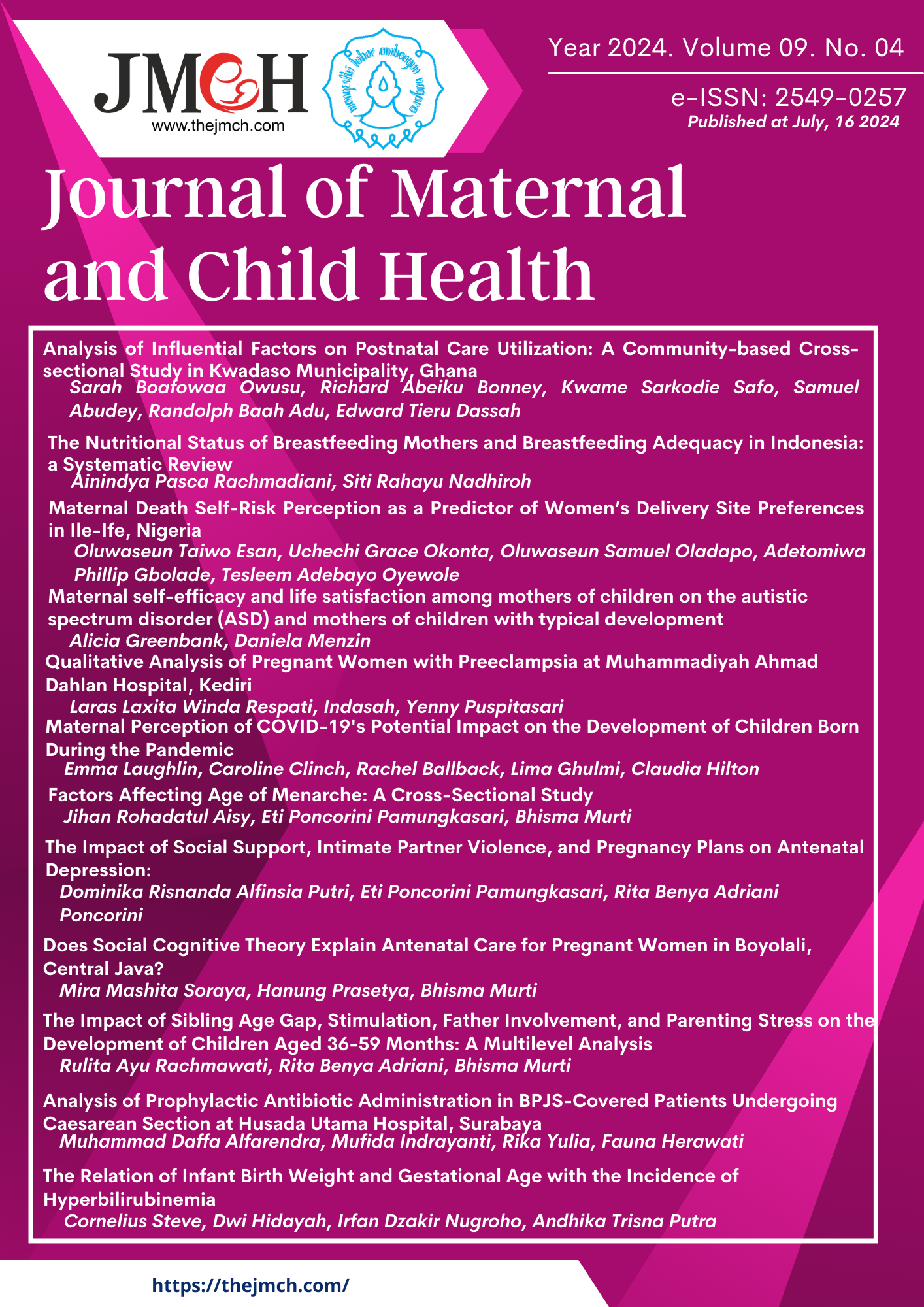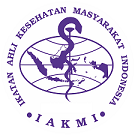Factors Affecting Age of Menarche: A Cross-Sectional
DOI:
https://doi.org/10.26911/thejmch.2024.09.04.07Abstract
Background: Early menarche or first menstruation has been associated with increased risk of breast cancer and cardiovascular disease. Understanding the factors that influence the age of menarche is very important to provide promotive and preventive actions that can be carried out by schools and families. This study aims to analyze the factors that influence the age of menarche.
Subjects and Method: This study used an observational analytical study with a cross-sectional design. The subjects in this study were 125 female students at 5 public elementary schools in Malang City, East Java, Indonesia. The dependent variable was the age of menarche. The independent variables were nutritional status (BMI), stress, parenting patterns, and parenting pattern dominance. Data analysis used univariate, bivariate, and multivariate models with multiple linear regression methods.
Results: Age of menarche decreased with stress (b = -0.50; 95% CI = -0.70 to -0.29; p <0.001), BMI ≥25 (b= -9.00; 95% CI = -16.75 to -1.25; p = 0.023), authoritarian parenting style (b = -1.05; 95% CI = -1.53 to -0.58; p<0.001), and the dominance of parenting patterns by single parents or guardians (b= -4.92; 95% CI = -9.42 to -0.42; p = 0.032). The age of menarche was higher in adolescents with a lower BMI than a normal BMI (b = 4.78; 95% CI = 1.20 to 8.36; p = 0.009). This multiple linear regression analysis model showed moderate model suitability with an Adj R-Squared value of 46.81%.
Conclusion: Multiple linear regression analysis showed a relationship between stress factors, authoritarian parenting patterns, dominant parenting patterns, and BMI with a decrease in the age of menarche which was statistically significant.
Keywords:
age of menarche, stress, authoritarian parenting, dominant parenting, BMIHow to Cite
References
Aghaee S, Deardorff J, Greenspan LC, Quesenberry CP, Kushi LH, Kubo A (2020). Early life household intactness and timing of pubertal onset in girls: a prospective cohort study. BMC Pediatri., 20(1). https://doi.org/10.1186/s1288702002345w
Asrullah M, L’Hoir M, Feskens EJM, Melse-Boonstra A (2022). Trend in age at menarche and its association with body weight, body mass index and non-communicable disease prevalence in Indonesia: evidence from the Indonesian Family Life Survey (IFLS). BMC Pub. Health, 22(1). https://doi.org/10.1186/s12889022129953
Calcaterra V, Cena H, Regalbuto C, Vinci F, Porri D, Verduci E, Chiara M, Zuccotti GV (2021). The role of fetal, infant, and childhood nutrition in the timing of sexual maturation. In Nutrients. 13(2): 1–15. https://doi.org/10.3390/nu13020419.
Cheng TS, Ong KK, Biro FM (2022). Adverse Effects of Early Puberty Timing in Girls and Potential Solutions. J Pediatr Adolesc Gynecol., 35(5): 532–535. https://doi.org/10.1016/j.jpag.2022.05.005.
Chung S (2017). Growth and puberty in obese children and implications of body composition. In J Obes. Metab. Syndr. (Vol. 26, Issue 4, pp. 243–250). Korean Society for the Study of Obesity. https://doi.org/10.7570/jomes.2017.26.4.243
Daniels SR (2021). Overweight is associated with early puberty in boys and girls. J. Pediatr. 230, 1–3. https://doi.org/10.1016/j.jpeds.2021.01.014
Demakakos P, Pashayan N, Chrousos G, Linara-Demakakou E, Mishra GD (2019). Childhood experiences of parenting and age at menarche, age at menopause and duration of reproductive lifespan: Evidence from the English Longitudinal Study of Ageing. Maturitas, 122, 66–72. https://doi.org/10.1016/j.maturitas.2019.01.010
DiLalla LF, Pham HT, Corley RP, Wadsworth S, Berenbaum SA (2021). Family Experiences and Parent Personality as Antecedents of Pubertal Timing in Girls and Boys. J. Youth and Adolesc, 50(5), 1017–1033. https://doi.org/10.1007/s10964-021-01424-0
Fatimah JM, Arianto, Bahfiarti T (2021). Media communication and youth reproductive health, North Toraja District. Gac Sanit., 35, S112–S115. https://doi.org/10.1016/j.gaceta.2021.07.007
Goldberg M, D’Aloisio AA, O’Brien KM, Zhao S, Sandler DP (2020). Pubertal timing and breast cancer risk in the Sister Study cohort. Breast Cancer Res., 22(1). https://doi.org/10.1186/s13058020013262
Johnston CA, Cavanagh SE, Crosnoe R (2020). Family structure patterns from childhood through adolescence and the timing of cohabitation among diverse groups of young adult women and men. Develop. Psycho, 56(1), 165–179. https://doi.org/10.1037/dev0000842
Kementerian Kesehatan Republik Indonesia (2018). Hasil Utama Riskesdas 2018.
Lee JJ, Cook-Wiens G, Johnson BD, Braunstein GD, Berga SL, Stanczyk FZ, Pepine CJ, Merz CNB, Shufelt CL (2019). Age at Menarche and Risk of Cardiovascular Disease Outcomes: Findings From the National Heart Lung and Blood Institute-Sponsored Women’s Ischemia Syndrome Evaluation. J. Am. Heart Assoc., 8(12). https://doi.org/10.1161/JAHA.119.012406
Ling H, Yan Y, Feng H, Zhu A, Zhang J, Yuan S (2022). Parenting Styles as a Moderator of the Association between Pubertal Timing and Chinese Adolescents′ Drinking Behavior. Inter. J. Environment. Res. and Pub. Health, 19(6). https://doi.org/10.3390/ijerph19063340
Malitha JM, Islam MA, Islam S, Al Mamun ASM, Chakrabarty S, Hossain MG (2020). Early age at menarche and its associated factors in school girls (age, 10 to 12 years) in Bangladesh: A cross-section survey in Rajshahi District, Bangladesh. J. Physiol. Anthropol., 39(1). https://doi.org/10.1186/s4010102000218w
Munanadia (2023). An Overview of The Reproductive Health of Teenage Girl in The Bereng Bengkel Village. BEMJ, 6(2), 45–50.
Pham HT, Dilalla LF, Corley RP, Dorn LD, Berenbaum SA (2021). Family Environmental Antecedents of Pubertal Timing in Girls and Boys: A Review and Open Questions.
Prosperi S, Chiarelli F (2023). Early and precocious puberty during the COVID-19 pandemic. In Front. Endocrinol. (Vol. 13). Frontiers Media S.A. https://doi.org/10.3389/fendo.2022.1107911.
Syam WDP, Gaytri SW, Muchsin AH, Bamahry AR, Laddo N (2022). Hubungan Status Gizi terhadap Usia Menarche (Relationship of Nutritional Status and Age of Menarche). Fakumi Med. J, 2(9), 637–645.
Taib B, Ummah DM, Bun Y (2020). Analisis Pola Asuh Otoriter Orang Tua Terhadap Perkembangan Moral Anak (Analysis of Authoritarian Parenting Patterns of Parents on Children's Moral Development). J. Pend. Guru PAUD, 3(1), 128–137.
Yu EJ, Choe SA, Yun JW, Son M (2020). Association of Early Menarche with Adolescent Health in the Setting of Rapidly Decreasing Age at Menarche. J Pediatr Adolesc Gynecol., 33(3), 264–270. https://doi.org/10.1016/j.jpag.2019.12.006
Yulita C, Devitasari I, Delika M, Eka HS, Raya P, Tengah K (2022). Gambaran Menarche pada Remaja Siswi di Sekolah Menengah Pertama Negeri 14 Palangkaraya (Menarche Overview in Female Students at State Junior High School 14, Palangkaraya). JSM, 50–56. https://doi.org/10.33084/jsm.vxix.xxx
Zhang L, Zhang D, Sun Y (2019). Adverse childhood experiences and early pubertal timing among girls: A meta-analysis. Int J Environ Res Public Health. 16(16). https://doi.org/10.3390/ijerph16162887










